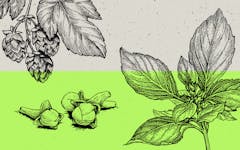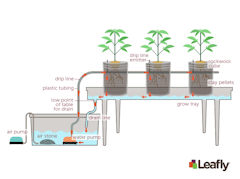A half is half an ounce, normally of cannabis bud, but it can also be shake. An ounce is 28 grams, making a half-ounce 14 grams. “Since I live three hours from the closest dispensary, I always buy a half so it lasts a long time.
The process of manually agitating cannabis plant material in ice water to break off trichomes to make bubble hash. Hand-washing is cheaper yet more labor intensive than machine washing. “I prefer hand-washing my hash for precision, even though it takes longer.” “Hand-washing is the best way to make ice water hash.
A technique done at the end of the purging process of cannabis extraction in which the extracted oil is agitated, or hand-whipped. This causes THCA to break away and crystallize, resulting in a waxy, opaque end concentrate. “You can tell shatter hasn’t been hand-whipped because it’s translucent.

The point at which mature cannabis plants are chopped down so buds can be trimmed, dried, and cured before smoking. “I got a huge yield out of my harvest!” Weed for dayyysss.” “I had to harvest early this year because the weather turned sour.

Hash, or hashish, refers to compacted cannabis resin (or kief) that is brown in color and more potent than cannabis flower. Cannabis flower is covered in glands that produce a sticky resin, which contains essential compounds like THC and CBD.
A hash hole is a type of large marijuana cigarette with premium hash placed in the center of it. As the joint burns, a hole where the hash burned forms in the middle of the ash. Thus, a hash hole. Hash holes may be also be called donuts.

A head shop is a slang and legacy term for a B2C lifestyle accessory business.
Head stash (aka headstash) is cannabis culture slang for your personal, private stash of cannabis, as opposed to the weed you share. As a cannabis dealer, your headstash might consist of high-grade cannabis than what you sold.

High-quality glass pipes prized for their artistry and the skill used to make them. Although they may seem more like art pieces than pipes, they don’t sacrifice function for form. “I usually save my heady glass pieces for special occasions.” “I dropped a wad of cash on a new heady glass piece.
The process of using heat from a butane torch or an e-nail to burn away residue or buildup left from a previous dab in a nail. “Heat cleaning shortens the usability of a banger by overexposing it to heat.
Cannabis products require testing for heavy metals, which are generally considered toxic and carcinogenic. Cannabis plants can draw them up from soil, and while trace amounts of some heavy metals, such as copper, selenium, and zinc, are needed for healthy functioning in the body, high amounts of them can cause poisoning.
Cannabis strains whose seeds or genetics have been preserved and passed down for generations. Heirloom strains differ from landraces in that they have been brought from their place of origin and cultivated by humans in a new environment. “I prefer the genetics of an old school heirloom strain to a modern hybrid any day.

Hemp is a form of cannabis that is traditionally used for creating textiles and other materials, and today is also used for CBD products. Since the passing of the Farm Bill in 2018, hemp with less than 0.3% THC can now widely be grown across the US for CBD products.
These full-spectrum cannabis concentrates have high levels of major and minor cannabinoids. This variation of full-spectrum extract preserves the most valuable components of the cannabis plant, placing particular emphasis on cannabinoid quality and content.
Full-spectrum cannabis concentrates containing a diverse range of terpenes in high concentrations. HFTSEs or “terp sauces” contain up to 40% terpenes and are coveted by consumers seeking the therapeutic potential of terpenes.
A flat, horizontal, disc-shaped percolator with many tiny holes that resembles a honeycomb. Honeycomb percs usually sit inside a bong or dab rig, whereas disc percs are welded to the body of the piece. “This honeycomb disc in my dab rig gives me big chugs.

Humulene is a terpene produced by the cannabis plant. Humulene contributes to the herbal aroma of not only cannabis, but of many other plants such as hops, sage, and ginseng. Although the full range of its properties in cannabis requires more study, humulene is believed to have anti-inflammatory benefits.
A cannabis plant that is the result of crossbreeding two other plants. Cannabis breeders often create hybrids to combine characteristics of the parent plants into one strain. What is a hybrid marijuana strain? A hybrid is any cannabis strain that results from the breeding of two other plants.
Cannabis plant extractions that use hydrocarbons such as butane, propane, and hexane to remove resin from the plant. Hydrocarbons are highly volatile and can be explosive, and are recommended to be used only by licensed, trained professionals. “I prefer hydrocarbon extractions like BHO instead of rosins.

A method of growing cannabis plants using water as a medium, rather than soil. In hydroponics, roots are suspended in water and water not initially absorbed gets recycled through the system for later use. “My friend grows some hydro that is absolutely killer.